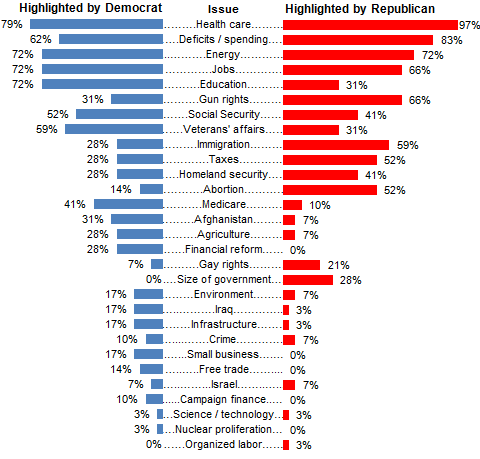Nate Silver has an interesting post on the extent that Republicans and Democrats are mentioning healthcare reform on their campaign websites and the tone in which they discuss it.
Excluding the broad subject of the economy, which we divided into several subcategories like jobs, taxes and deficits, health care was the most frequently mentioned issue. Of the 29 Republicans in these pivotal districts, all but one mentioned it, with many suggesting that the Democrats’ bill should be repealed. But health care was also highlighted by 23 of the 29 Democrats, making it the most cited issue among that party as well.
The post is definitely worth a read. What really interested me, however, was this graph that summarized the percentage of campaign websites reviewed by 538 that mentioned each of the listed issues.:
What I found absolutely fascinating was the stuff that candidates were not mentioning. That Democrats across the board would not be touting the party’s victory in financial reform is surprising, and the failures to mention science/technology, the environment, and (especially) infrastructure seem indicative of candidates who are sprinting to the center rather than embracing the progressive side of the party. This is to be expected in some states, especially in the South and Southwest, but we’re talking about a list that includes, among others, New Hampshire and Wisconsin.
On the Republican side, no one wants to touch Medicare (despite its role in the HCR bill), Afghanistan, or financial reform, and I guess none of these omissions is particularly surprising. What is a little startling, though, is the lack of reference to small businesses, considering how much of the GOP economic narrative centers on Obama/Pelosi killing jobs by hurting small businesses.
I suppose some of the omissions on both sides stem from the fact that these races are toss-ups at the moment; no one wants to risk alienating voters by identifying too fully with their party (especially on the Dem side). That said, when one looks at the enthusiasm gap between Democrats and Republicans right now, you can’t help but wonder if this watering down of the Democrats’ message and their corresponding run-to-the-right strategy is much more a cause of the gap than a solution to it.
